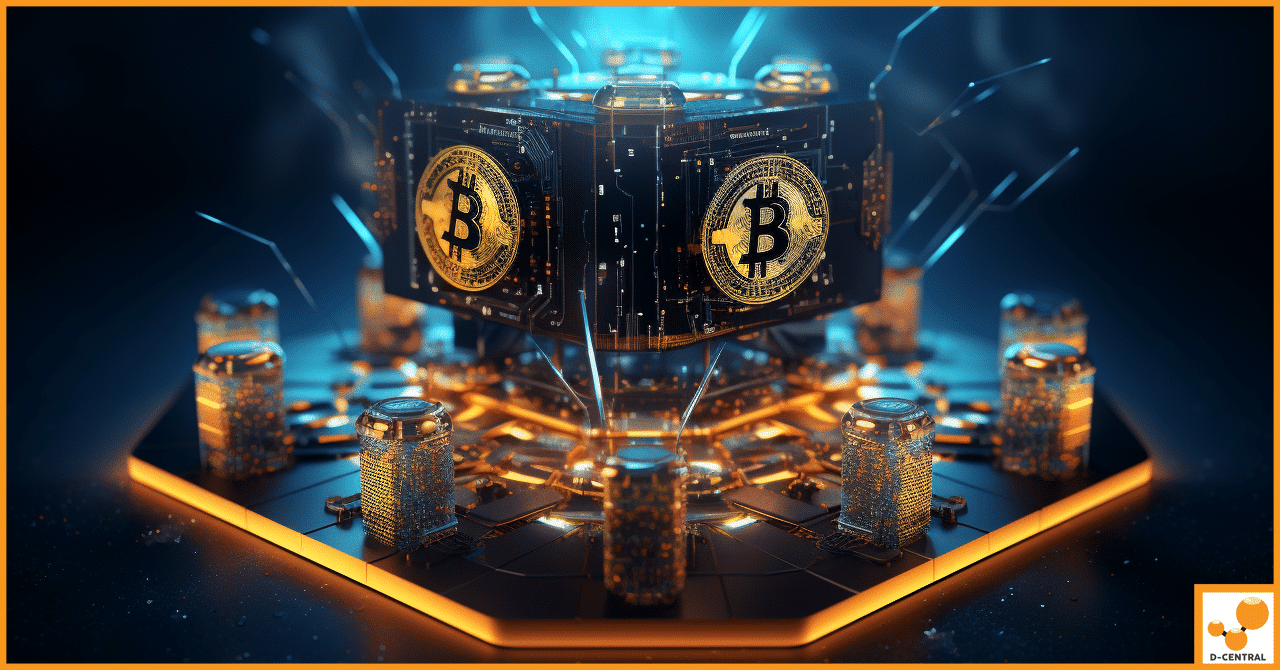
How to Start Bitcoin Mining in 2023 A Step-by-step Guide
In the continuously evolving world of digital currencies, one term that has stood the test of time is “Bitcoin Mining.”
4479 Desserte Nord Autoroute 440, Laval, QC H7P 6E2

Bitcoin mining is a crucial process in the cryptocurrency ecosystem, responsible for processing transactions and securing the network while creating new coins. At the heart of mining lies the need for powerful computing hardware that solves complex cryptographic puzzles. However, this intense computational effort generates significant heat, which if not adequately managed, can reduce the efficiency of the mining operation and shorten the lifespan of the expensive mining equipment.
The traditional method of cooling mining rigs has been air cooling—using fans to circulate air and heat sinks to dissipate heat. While effective to a degree, air cooling has its limitations, especially as mining hardware becomes more powerful and densely packed. The fans can be noisy, and in hotter climates or during intense mining operations, air cooling may not suffice to keep the temperatures within safe operational limits.
This is where liquid cooling comes into play as a superior alternative. Liquid cooling systems use a fluid to transfer heat from the mining hardware to a radiator, which then expels it away from the equipment. This method is generally more efficient than air cooling because liquids are better at conducting heat than air. Moreover, liquid cooling systems operate at lower noise levels, making them ideal for setups in residential areas or where noise is a concern.
When comparing liquid cooling to the newer technology of immersion cooling—where the entire mining rig is submerged in a thermally conductive, non-electrically conductive liquid—the differences become more pronounced. Immersion cooling is even more efficient at heat removal and allows for a denser configuration of mining hardware. However, it also involves higher setup complexities and costs, making liquid cooling a more accessible middle ground for many miners.
In this article, we will delve deeper into the mechanisms of liquid cooling, exploring its components, setup, and maintenance. We will also provide a comparative overview with immersion cooling to help you decide which cooling solution best fits your Bitcoin mining needs.
Bitcoin mining involves a computational race to solve cryptographic puzzles, a process that is both power-intensive and generates considerable heat. The ability to effectively dissipate this heat is crucial, not only for maintaining optimal performance but also for extending the lifespan of the mining hardware. Here’s why liquid cooling emerges as a vital technology in the context of Bitcoin mining:
Bitcoin mining rigs, especially those equipped with powerful ASICs and GPUs, generate a significant amount of heat. If this heat isn’t managed properly, it can lead to thermal throttling where the hardware automatically slows down to prevent damage, or worse, it can cause permanent damage to the components. The challenge intensifies in densely packed mining setups or in climates that are naturally warmer, where traditional cooling methods struggle to maintain a safe operating temperature.
Efficiency: Liquid cooling is far more efficient than air cooling due to the properties of the cooling medium. Liquids have a higher capacity to absorb and transfer heat compared to air. This superior heat transfer capability allows liquid cooling systems to quickly and efficiently remove heat from the core components of mining rigs, maintaining an optimal operating temperature and thus improving the overall hashing efficiency.
Noise Reduction: Unlike air-cooled systems that rely on multiple high-speed fans, liquid cooling systems are significantly quieter. This reduction in noise is due to the reliance on water blocks and radiators that do not require fan cooling at high RPMs. For miners operating in residential areas or where noise could be an issue, liquid cooling offers a distinct advantage.
Hardware Longevity: By maintaining lower temperatures, liquid cooling systems reduce the thermal stress on mining hardware, which can significantly extend the lifespan of the components. Cooler operating temperatures mean that electronic components such as GPUs and ASICs are less likely to suffer from heat-related wear and tear over time.
Liquid cooling systems are not only more efficient at transferring heat but also tend to consume less energy compared to air-cooled systems under similar conditions. This efficiency translates to lower electricity costs, crucial for profitability in mining operations where energy consumption can be the largest overhead.
Moreover, the operational costs associated with maintaining a liquid cooling system can be lower over time. Although the initial setup cost for a liquid cooling system may be higher, the reduced need for replacement parts, less frequent maintenance, and lower energy bills contribute to a more cost-effective solution in the long run.
In summary, while the upfront cost and setup complexity of liquid cooling systems might be greater than traditional air cooling, the benefits of improved efficiency, quieter operation, and extended hardware life often outweigh these initial challenges, making it a compelling choice for serious Bitcoin miners.
Liquid cooling systems are complex assemblies designed to manage heat more effectively than traditional air cooling. Each component plays a crucial role in the process, ensuring that mining rigs operate efficiently and reliably under optimal temperatures. Here’s an overview of each component and its function:
Functionality: Coolants are the lifeblood of any liquid cooling system. They are typically made from water or a glycol-water mixture but can also include more advanced fluids that enhance thermal conductivity and resist corrosion. The primary job of the coolant is to absorb heat from the mining rig’s components and transport it away to be dissipated.
Functionality: The pump is the heart of the liquid cooling system. It circulates coolant throughout the system, ensuring continuous heat absorption from the mining hardware. A strong and reliable pump helps maintain consistent flow rates and pressures across all parts of the system, which is vital for effective cooling performance.
Functionality: Radiators act like the lungs of the cooling system. They are designed to dissipate the heat absorbed by the coolant into the surrounding environment. Radiators come in various sizes and thicknesses, with larger ones providing more surface area to aid in faster heat dissipation.
Functionality: Water blocks serve as the point of contact between the heat source and the coolant. They are attached directly to heat-generating components like CPUs, GPUs, or ASIC chips. Water blocks transfer the heat from these components into the coolant. The efficiency of a water block in absorbing heat is critical to the overall effectiveness of the cooling system.
Functionality: Reservoirs provide a storage space for extra coolant within the system. They are essential for maintaining the coolant volume necessary for optimal system performance. Reservoirs also allow for easier maintenance and filling of the coolant, and they help to eliminate air bubbles from the system, which can impede cooling performance.
Functionality: Tubing connects all components of the liquid cooling system, forming the channels through which the coolant flows. The quality and layout of the tubing affect the efficiency and aesthetic of the entire system. Flexible tubing is easier to install but may kink, reducing flow rates, while rigid tubing offers cleaner aesthetics and better flow but requires more precise installation.
These components work together to form a highly efficient system that maintains the mining hardware at optimal temperatures, thereby enhancing performance and extending the lifespan of the equipment. Each component’s design and quality can significantly affect the overall cooling efficiency, making it crucial to choose high-quality parts when setting up a liquid cooling system.
Installing a liquid cooling system for Bitcoin mining requires meticulous planning and execution to ensure maximum efficiency and prevent any potential issues. Here’s a step-by-step guide on how to set up a liquid cooling system tailored for the needs of Bitcoin miners, along with tips on selecting the right components and avoiding common installation pitfalls.
By carefully following these steps, selecting the right components, and being aware of common pitfalls, you can effectively install and maintain a liquid cooling system that enhances the performance and longevity of your Bitcoin mining rigs.
Maintaining a liquid cooling system is crucial for ensuring that your Bitcoin mining operation runs efficiently and safely. Regular maintenance can prevent common issues like leaks, blockages, and coolant degradation, which could otherwise lead to system failure or inefficient cooling. Here’s a guide on routine maintenance tasks, troubleshooting common issues, and the proper ways to replace and dispose of coolants.
Maintaining your liquid cooling system through these best practices not only extends the life of your mining equipment but also ensures that your mining setup remains efficient and effective. Regular checks and maintenance can save significant time and money by preventing larger issues down the line.
Immersion cooling represents a sophisticated technology in the field of cryptocurrency mining, offering a fundamentally different approach from traditional air or liquid cooling methods. This technology involves submerging electronic components directly into a non-conductive liquid that dissipates heat effectively.
Immersion cooling systems use dielectric fluids that are excellent at absorbing heat but do not conduct electricity. This method cools the mining hardware by direct contact with the fluid, which then transfers the absorbed heat to a heat exchanger or cooling tower. Unlike air and traditional liquid cooling that use coolants to transfer heat from a component to a radiator system, immersion cooling exposes the components directly to the cooling medium.
Pros:
Cons:
Several large-scale mining operations have adopted immersion cooling to enhance their efficiency and scalability:
These case studies indicate that immersion cooling, despite its higher initial investment and complexity, offers substantial long-term benefits in terms of efficiency, noise reduction, and operational cost savings, making it an attractive option for large-scale mining operations looking to optimize performance and costs.
Liquid Cooling: Liquid cooling systems are generally more cost-effective for individual miners or smaller setups due to their relatively lower initial setup and operational costs compared to immersion cooling. They provide a significant improvement in heat management and efficiency over traditional air cooling, which can lead to lower energy bills and improved hardware longevity. However, the maintenance and the periodic replacement of components such as pumps and coolants can add to the operational costs over time.
Immersion Cooling: For large-scale mining operations, immersion cooling, while expensive to set up, can be more cost-effective in the long run. The high initial investment is offset by substantial reductions in cooling and maintenance costs. Immersion cooling systems use less energy than conventional cooling methods because they eliminate the need for air conditioning and extensive fan setups. They also increase the operational efficiency and lifespan of the mining hardware, which can result in higher profitability over an extended period.
Energy Savings: Both liquid and immersion cooling technologies significantly reduce the amount of energy required for cooling mining operations. This reduction is crucial given the energy-intensive nature of Bitcoin mining. Immersion cooling is particularly effective at energy conservation, as it can reduce the cooling energy consumption by up to 90% compared to traditional methods.
Sustainable Practices: Immersion cooling technology not only saves energy but also allows for the reuse of heat. For instance, the waste heat generated by mining operations can be repurposed for heating buildings or industrial processes, adding a layer of sustainability. Furthermore, the use of non-toxic and biodegradable coolants in some advanced cooling systems minimizes environmental hazards associated with coolant disposal.
Future Trends in Cooling Technology
The future of cooling technologies in Bitcoin mining looks promising, with ongoing innovations aimed at increasing efficiency and reducing environmental impact. The trend is moving towards more sustainable practices, including the development of new materials and coolants that are more efficient at heat transfer and are environmentally friendly. There is also a growing interest in integrating renewable energy sources with cooling technologies to create a more sustainable mining infrastructure.
Effects on the Mining Industry: As cooling technology advances, we can expect mining operations to become more cost-efficient and less environmentally damaging. This shift will not only improve the profitability of mining operations but also help in addressing the significant criticism that Bitcoin mining faces regarding its environmental impact. The adoption of advanced cooling solutions, coupled with renewable energy, could potentially reshape the public perception and regulatory landscape for the mining industry.
In summary, both liquid and immersion cooling technologies offer distinct advantages in terms of cost-effectiveness and environmental impact. As the industry continues to evolve, these cooling solutions will play a crucial role in shaping the future of Bitcoin mining, making it more sustainable and economically viable.
Liquid cooling systems offer significant advantages for Bitcoin mining operations, improving the efficiency, longevity, and overall performance of mining hardware. These systems efficiently manage the immense heat generated by mining activities, ensuring that hardware operates within optimal temperature ranges. This not only boosts the immediate operational capacity but also extends the life of the equipment by preventing overheating and associated damages.
For miners contemplating an upgrade from traditional air cooling to more advanced systems, liquid cooling offers a balanced approach. It provides superior cooling capabilities compared to air cooling and is generally less complex and costly than full-scale immersion cooling systems. Miners should assess their current and future scaling plans, budget constraints, and specific operational needs when deciding on the appropriate cooling technology.
Miners are encouraged to adopt sustainable and efficient cooling solutions to not only enhance the profitability of their operations but also reduce their environmental impact. By integrating advanced cooling technologies and considering potential reuse of waste heat, mining operations can become more energy-efficient and environmentally friendly. This shift is not just beneficial for cost management but crucial for aligning with global sustainability goals.
Given the complexities and variations in mining operations, speaking with a cooling systems expert can provide tailored advice to ensure that your setup is optimized for both performance and cost-efficiency. An expert can help navigate the specifics of your operation, recommend the best cooling solutions, and guide you through the installation and maintenance processes.
These resources provide valuable information on the current trends and future directions in mining technologies, helping miners stay ahead in a rapidly evolving industry. By staying informed, miners can make better decisions that enhance their operation’s efficiency and sustainability.
What are the main challenges of Bitcoin mining?
The main challenges of Bitcoin mining include managing the significant heat generated by mining hardware, maintaining operational efficiency, and extending the lifespan of the expensive mining equipment.
Why is liquid cooling superior to air cooling for Bitcoin mining?
Liquid cooling is superior to air cooling because it is more efficient at transferring heat away from mining hardware, operates at lower noise levels, and can keep the mining setup cooler, thus improving the performance and longevity of the mining equipment.
What are the benefits of liquid cooling for mining rigs?
The benefits of liquid cooling for mining rigs include improved thermal efficiency, reduced noise, extended hardware longevity, and potentially lower energy consumption and operational costs compared to traditional air cooling methods.
How does immersion cooling differ from liquid cooling?
Immersion cooling differs from liquid cooling by submerging the entire mining rig in a non-electrically conductive liquid, providing even more efficient heat removal and allowing for denser hardware configurations, albeit at higher setup complexities and costs.
What are the core components of a liquid cooling system?
The core components of a liquid cooling system include coolants, pumps, radiators, water blocks, reservoirs, and tubing, each playing a vital role in efficiently transferring heat away from the mining hardware.
What routine maintenance tasks are essential for liquid cooling systems in Bitcoin mining?
Essential routine maintenance tasks for liquid cooling systems include checking coolant levels, inspecting for leaks, cleaning radiators and fans, flushing the system annually, and monitoring system temperatures.
What are the economic and environmental impacts of liquid and immersion cooling systems in Bitcoin mining?
Liquid and immersion cooling systems can significantly reduce energy consumption and operational costs, with immersion cooling being highly efficient but more suited for large-scale operations due to higher initial costs. Both technologies offer environmental benefits by reducing the carbon footprint of mining operations and potentially enabling the reuse of waste heat.
What future trends in cooling technology could impact the Bitcoin mining industry?
Future trends in cooling technology include the development of more efficient and environmentally friendly coolants, the integration of renewable energy sources with cooling systems, and innovations aimed at reducing the overall environmental impact of Bitcoin mining, potentially making mining operations more sustainable and economically viable.
DISCLAIMER: D-Central Technologies and its associated content, including this blog, do not serve as financial advisors or official investment advisors. The insights and opinions shared here or by any guests featured in our content are provided purely for informational and educational purposes. Such communications should not be interpreted as financial, investment, legal, tax, or any form of specific advice. We are committed to advancing the knowledge and understanding of Bitcoin and its potential impact on society. However, we urge our community to proceed with caution and informed judgment in all related endeavors.
Related Posts

In the continuously evolving world of digital currencies, one term that has stood the test of time is “Bitcoin Mining.”

In the annals of financial history, the emergence of Bitcoin in 2009 marked a pivotal moment, introducing the world to

In the ever-evolving landscape of digital currencies, Bitcoin stands as a pioneering force that has reshaped our understanding of financial